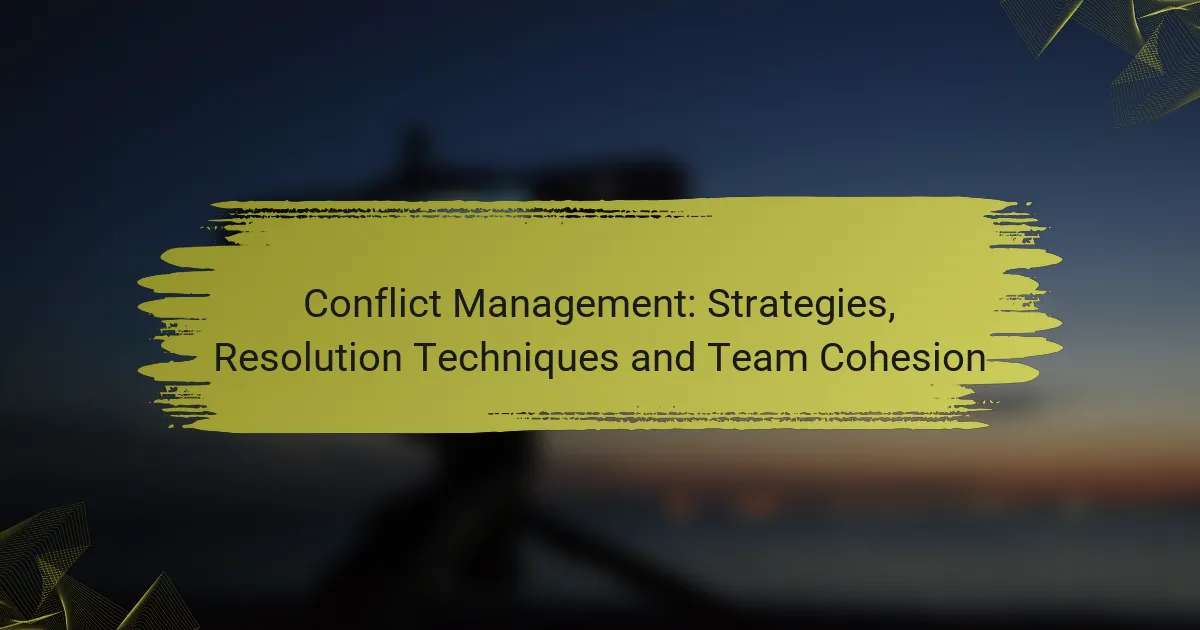Conflict management is essential for maintaining a harmonious and productive team environment. By employing effective strategies and resolution techniques, teams can address disputes while strengthening relationships and promoting cohesion. Fostering open communication and collaboration not only helps in resolving conflicts but also enhances overall team unity.
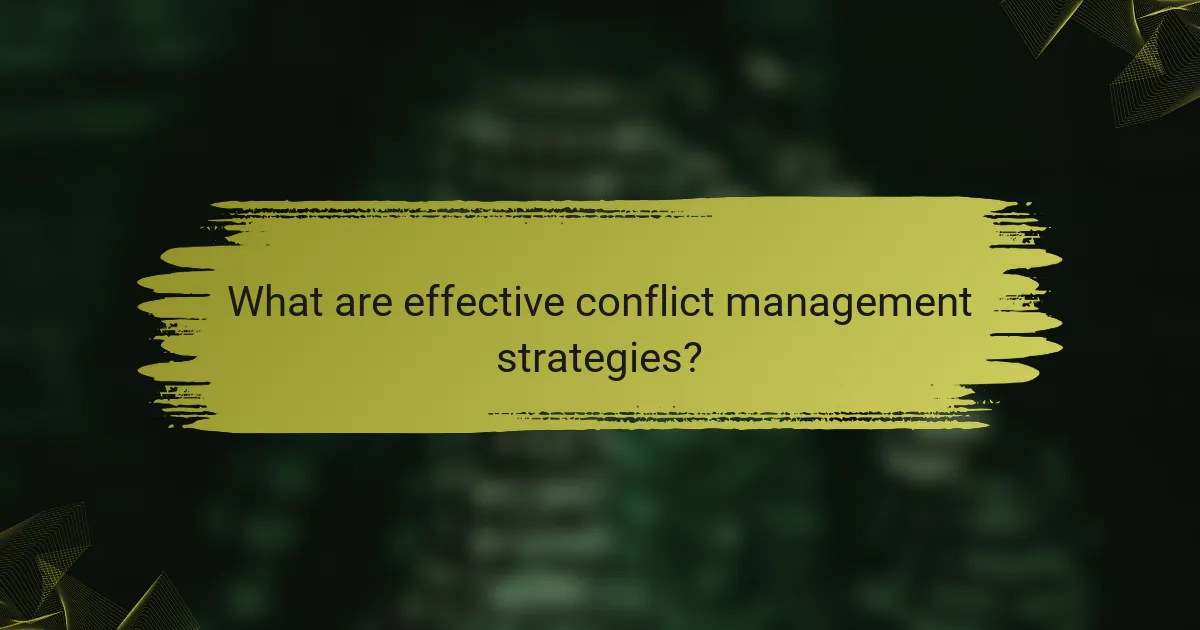
What are effective conflict management strategies?
Effective conflict management strategies focus on resolving disputes while maintaining positive relationships among team members. These strategies aim to address the underlying issues, promote understanding, and foster collaboration.
Collaborative problem-solving
Collaborative problem-solving involves bringing conflicting parties together to work towards a mutually beneficial solution. This approach encourages open dialogue, allowing each party to express their concerns and needs. By focusing on shared goals, teams can often find innovative solutions that satisfy everyone involved.
To implement collaborative problem-solving, set a neutral environment, establish ground rules for discussion, and encourage brainstorming without judgment. This method can lead to stronger team cohesion and trust.
Mediation techniques
Mediation techniques involve a neutral third party who facilitates discussions between conflicting individuals or groups. The mediator helps clarify issues, encourages communication, and guides the parties towards a resolution. This approach is particularly useful when direct communication has broken down.
Effective mediation requires active listening skills, neutrality, and the ability to manage emotions. It’s important to ensure that all parties feel heard and respected during the process, which can lead to a more amicable resolution.
Active listening practices
Active listening practices are essential in conflict management as they promote understanding and empathy. This technique involves fully concentrating on what the other person is saying, reflecting back their thoughts, and asking clarifying questions. By demonstrating that you value their perspective, you can reduce tension and foster a more constructive dialogue.
To practice active listening, avoid interrupting, maintain eye contact, and summarize what the other person has said to confirm understanding. This can significantly improve communication and help resolve conflicts more effectively.
Negotiation tactics
Negotiation tactics are strategies used to reach an agreement that satisfies all parties involved in a conflict. Effective negotiation requires preparation, understanding the interests of both sides, and being willing to compromise. Techniques such as identifying common ground and proposing win-win solutions can enhance the negotiation process.
When negotiating, it’s crucial to remain calm and focused, avoid personal attacks, and be open to alternative solutions. Establishing clear objectives and knowing your limits can also help in achieving a favorable outcome.
Conflict resolution training
Conflict resolution training equips team members with the skills and techniques necessary to manage disputes effectively. This training often includes role-playing scenarios, communication exercises, and strategies for de-escalation. By investing in such training, organizations can foster a culture of collaboration and reduce the frequency and intensity of conflicts.
Consider offering regular workshops or online courses that cover key conflict management strategies. Providing ongoing support and resources can help reinforce these skills and encourage a proactive approach to conflict resolution within teams.
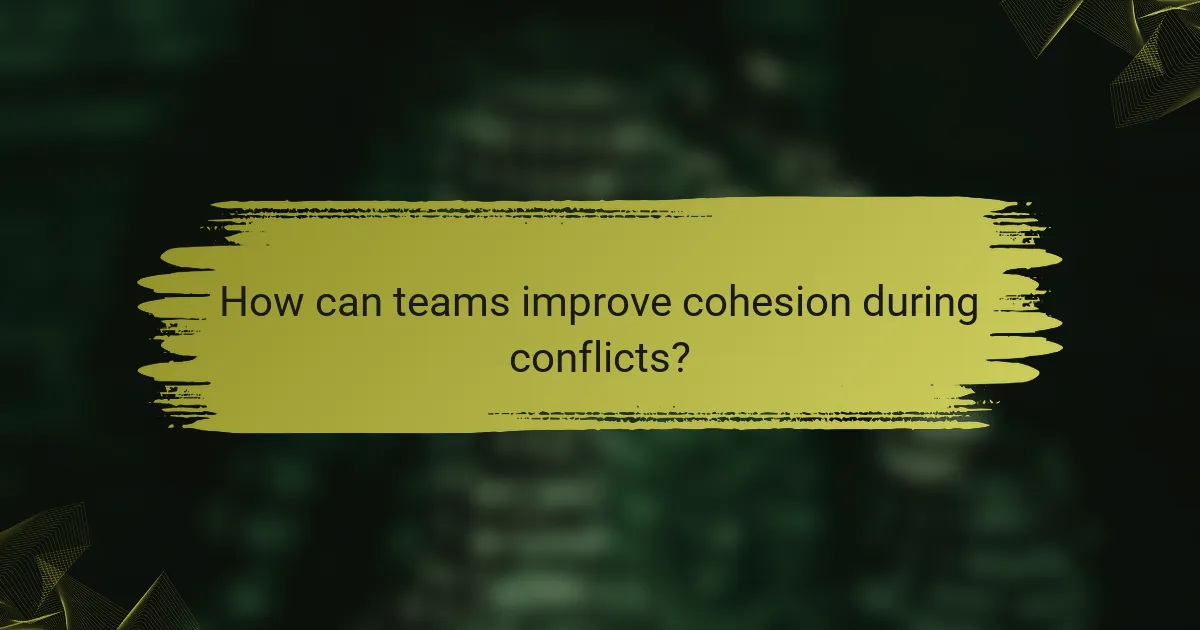
How can teams improve cohesion during conflicts?
Teams can enhance cohesion during conflicts by fostering an environment of collaboration and understanding. Implementing strategies like team-building exercises, maintaining open communication, and establishing common goals can significantly reduce tension and promote unity.
Team-building exercises
Team-building exercises are activities designed to strengthen relationships and improve teamwork. These can range from simple icebreakers to more complex problem-solving tasks that require collaboration. Regularly scheduled exercises help team members develop trust and familiarity, which can ease conflicts when they arise.
Consider activities like escape rooms or outdoor challenges that require joint effort. Aim for at least one team-building event every few months to keep relationships strong and communication flowing.
Open communication channels
Establishing open communication channels is crucial for resolving conflicts effectively. Teams should encourage members to express their thoughts and feelings without fear of retribution. Regular check-ins, feedback sessions, and anonymous suggestion boxes can facilitate honest dialogue.
Utilize tools like Slack or Microsoft Teams to create dedicated channels for conflict resolution discussions. This ensures that everyone has a voice and can contribute to solutions, fostering a culture of transparency and support.
Establishing common goals
Setting common goals aligns team members towards a shared purpose, reducing friction during disagreements. When everyone understands and commits to the same objectives, it becomes easier to navigate conflicts constructively. Clearly defined goals should be specific, measurable, and achievable.
Consider using the SMART criteria (Specific, Measurable, Achievable, Relevant, Time-bound) to outline these goals. Regularly revisit and adjust them as necessary to keep the team focused and cohesive, especially during challenging times.

What are the best resolution techniques for workplace conflicts?
The best resolution techniques for workplace conflicts include interest-based negotiation, facilitated discussions, and structured conflict resolution frameworks. These methods focus on understanding the underlying issues, promoting open communication, and providing systematic approaches to resolving disputes effectively.
Interest-based negotiation
Interest-based negotiation emphasizes collaboration over competition, aiming to satisfy the underlying interests of all parties involved. This technique encourages participants to express their needs and concerns openly, fostering a problem-solving mindset.
Key steps include identifying mutual interests, brainstorming options for mutual gain, and evaluating solutions based on fairness and feasibility. For example, if two team members dispute project responsibilities, they can negotiate roles that align with their strengths and preferences.
Facilitated discussions
Facilitated discussions involve a neutral third party who guides the conversation, ensuring that all voices are heard and that the dialogue remains constructive. This approach can help de-escalate tensions and clarify misunderstandings.
During these discussions, the facilitator sets ground rules, encourages respectful communication, and helps identify common goals. For instance, a manager might facilitate a meeting between conflicting team members to clarify expectations and rebuild trust.
Conflict resolution frameworks
Conflict resolution frameworks provide structured processes for addressing disputes systematically. These frameworks often include steps such as defining the problem, exploring options, and agreeing on a solution.
Common frameworks include the Thomas-Kilmann Conflict Mode Instrument and the Interest-Based Relational Approach. Organizations may adopt these frameworks to create a consistent approach to conflict management, ensuring that employees have clear guidelines to follow when issues arise.
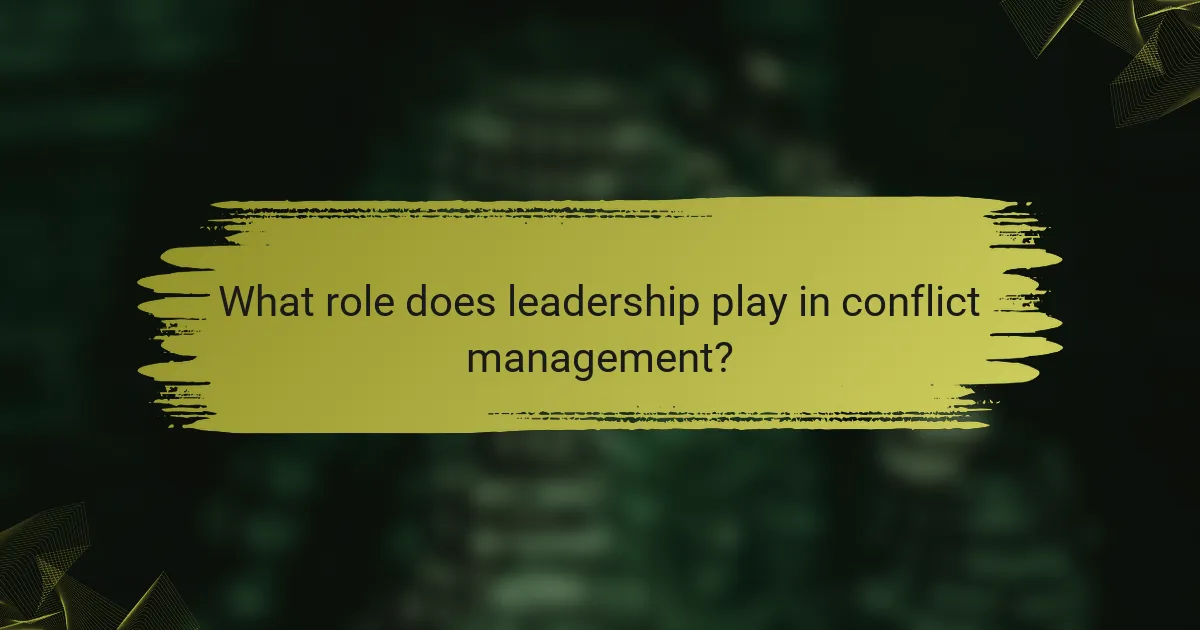
What role does leadership play in conflict management?
Leadership plays a crucial role in conflict management by setting the tone for how conflicts are addressed within a team. Effective leaders model appropriate behaviors, facilitate open communication, and provide necessary resources to navigate conflicts constructively.
Setting a positive example
Leaders must demonstrate positive conflict resolution behaviors to influence their teams. By handling disagreements calmly and respectfully, they create an environment where team members feel safe to express their concerns. For instance, a leader who actively listens and acknowledges different viewpoints encourages similar behaviors among team members.
Additionally, showcasing vulnerability by admitting mistakes can foster trust and openness. This approach helps to normalize conflict as a natural part of teamwork, rather than something to be avoided.
Encouraging a culture of feedback
Creating a culture where feedback is welcomed and valued is essential for effective conflict management. Leaders should encourage team members to share their thoughts and feelings regularly, which can help identify potential conflicts before they escalate. Regular check-ins and feedback sessions can facilitate this process.
Moreover, implementing structured feedback mechanisms, such as anonymous surveys or peer reviews, can provide insights into team dynamics. This proactive approach allows leaders to address issues early and maintain team cohesion.
Providing conflict resolution resources
Leaders should equip their teams with tools and resources to manage conflicts effectively. This can include training sessions on conflict resolution techniques, access to mediation services, or workshops that focus on communication skills. Providing these resources empowers team members to handle disputes independently.
Additionally, establishing clear protocols for conflict resolution can guide team members on how to approach disagreements. For example, outlining steps to follow when a conflict arises can help ensure that issues are addressed promptly and constructively, minimizing disruption to team productivity.
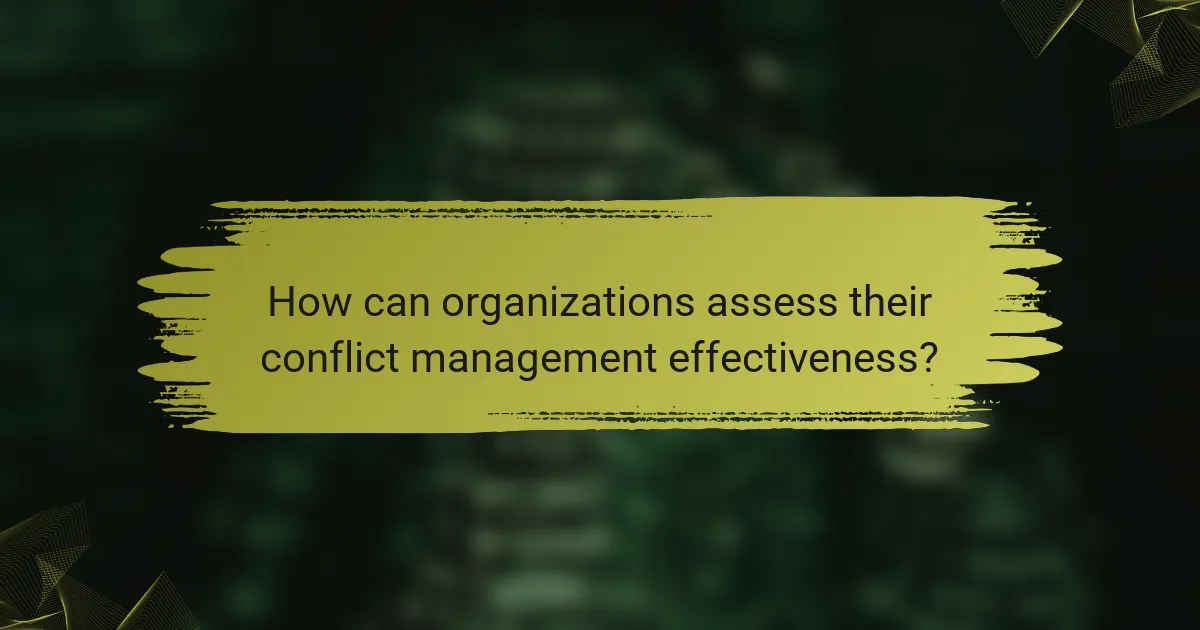
How can organizations assess their conflict management effectiveness?
Organizations can assess their conflict management effectiveness by utilizing various tools and metrics that provide insights into employee perceptions and outcomes related to conflict resolution. Regular evaluations through feedback mechanisms and performance indicators help identify strengths and areas for improvement in conflict management strategies.
Employee feedback surveys
Employee feedback surveys are a direct way to gauge perceptions of conflict management within an organization. These surveys can include questions about employees’ experiences with conflict resolution processes, their satisfaction with outcomes, and their overall feelings of safety and support in the workplace.
To ensure effectiveness, surveys should be anonymous and conducted regularly, allowing for trend analysis over time. Organizations might consider including open-ended questions to capture detailed insights and suggestions for improvement.
Conflict resolution metrics
Conflict resolution metrics provide quantifiable data on how conflicts are managed and resolved within a team or organization. Key metrics might include the average time taken to resolve conflicts, the number of conflicts escalated to higher management, and the recurrence rate of similar conflicts.
Tracking these metrics can help organizations identify patterns and areas needing attention. For instance, if conflicts are frequently unresolved within a specific department, targeted training or mediation strategies may be necessary to enhance conflict management skills.
Performance reviews
Integrating conflict management assessments into performance reviews can provide a comprehensive view of an employee’s ability to handle disputes. Managers can evaluate how well employees collaborate, communicate, and resolve conflicts, which are essential skills in team dynamics.
To make this effective, performance reviews should include specific examples of conflict situations and the employee’s responses. This approach not only highlights strengths but also identifies areas for development, leading to tailored training and support initiatives.

What are the prerequisites for effective conflict resolution?
Effective conflict resolution requires clear communication, mutual respect, and a willingness to understand differing perspectives. Establishing these prerequisites fosters an environment where team members feel safe to express their concerns and work collaboratively towards solutions.
Understanding team dynamics
Team dynamics refer to the interactions and relationships among team members that influence their behavior and performance. Recognizing these dynamics is crucial for addressing conflicts, as they often stem from misunderstandings or misalignments in roles and expectations.
To effectively manage conflicts, consider the roles each team member plays and how their personalities interact. For example, a dominant personality may clash with a more reserved member, leading to tension. Understanding these dynamics can help identify potential conflict triggers and facilitate smoother resolutions.
Encouraging open dialogue about team dynamics can prevent conflicts from escalating. Regular check-ins and team-building activities can strengthen relationships and improve communication, making it easier to address issues as they arise. Establishing ground rules for discussions can also help maintain a respectful atmosphere during conflict resolution.
